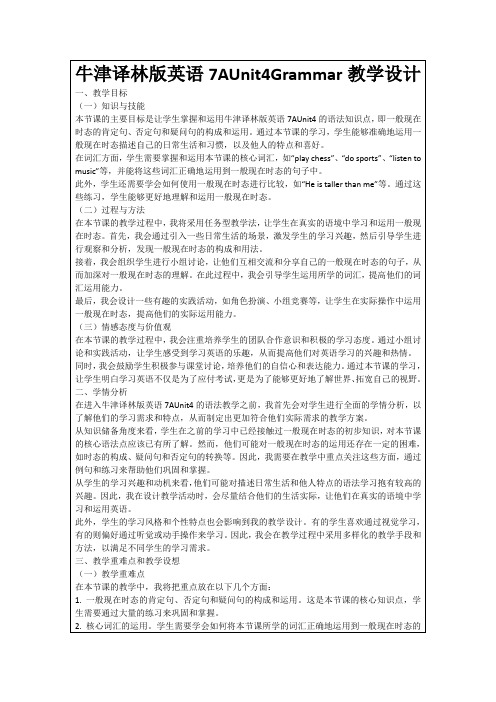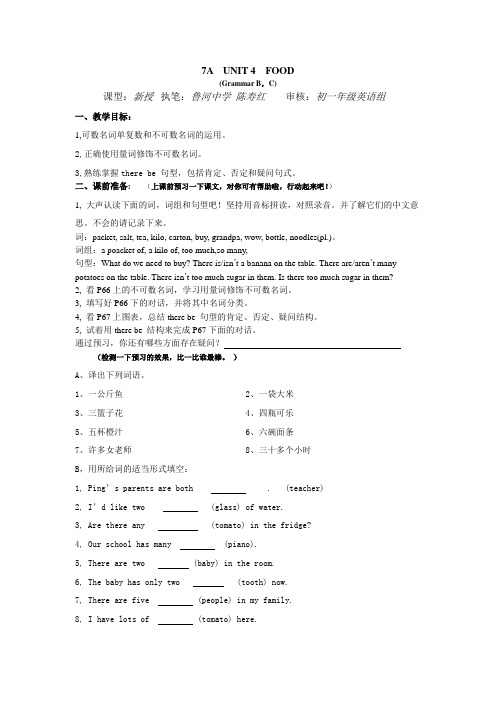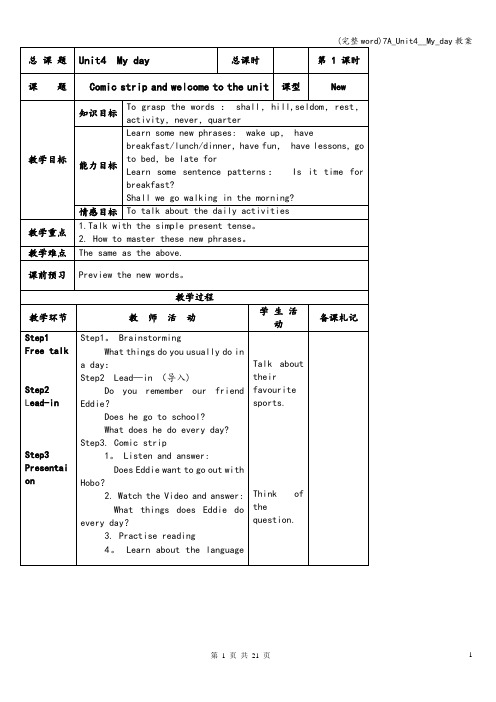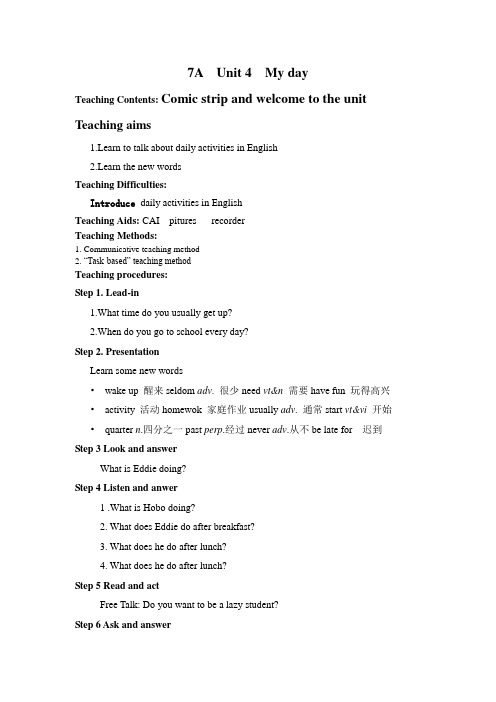7Aunit4教案
- 格式:doc
- 大小:266.50 KB
- 文档页数:30



7A UNIT 4 FOOD(Grammar B,C)课型:新授执笔:鲁河中学陈寿红审核:初一年级英语组一、教学目标:1,可数名词单复数和不可数名词的运用。
2,正确使用量词修饰不可数名词。
3,熟练掌握there be 句型,包括肯定、否定和疑问句式。
二、课前准备: (上课前预习一下课文,对你可有帮助啦,行动起来吧!)1, 大声认读下面的词,词组和句型吧!坚持用音标拼读,对照录音。
并了解它们的中文意思。
不会的请记录下来。
词:packet, salt, tea, kilo, carton, buy, grandpa, wow, bottle, noodles(pl.)。
词组:a poacket of, a kilo of, too much,so many,句型:What do we need to buy? There is/isn’t a banana on the table. There are/aren’t many potatoes on the table. There isn’t too much sugar in them. Is there too much sugar in them?2, 看P66上的不可数名词,学习用量词修饰不可数名词。
3, 填写好P66下的对话,并将其中名词分类。
4, 看P67上图表,总结there be 句型的肯定、否定、疑问结构。
5, 试着用there be 结构来完成P67下面的对话。
通过预习,你还有哪些方面存在疑问?(检测一下预习的效果,比一比谁最棒。
)A、译出下列词语。
1、一公斤鱼2、一袋大米3、三篮子花4、四瓶可乐5、五杯橙汁6、六碗面条7、许多女老师 8、三十多个小时B,用所给词的适当形式填空:1, Ping’s parents are both . (teacher)2, I’d like two (glass) of water.3, Are there any (tomato) in the fridge?4, Our school has many (piano).5, There are two (baby) in the room.6, The baby has only two (tooth) now.7, There are five (people) in my family.8, I have lots of (tomato) here.9, The (child) are playing games on the playground now.10, They are (woman) (doctor).三、知识链接:1, 用量词修饰不可数名词: two glasses of water,two glasses of juice, a piece of bread, two pieces of paper,five kilos of chicken, a can of Coke……量词有单复数变化。


初一年级英语学科教课设计总课题课题教课目的教课要点教课难点课前预习教课过程教课环节Step1 CheckStep2 Presentation Unit4 My day总课时7第1课时Comic strip & Welcome to the unit课型NewMake Ss grasp the new words and phrases: wake up,知识目标seldom, go out, have fun, have lessons, activity, never, be late for, start, quarter, past能力目标Enable Ss to talk about their daily activities and theirschool life感情目标Cultivate Ss’ability of arranging their daily life and theirlove for school lifeTalk about their daily activities in English.Talk about their daily activities in English.Preview the new words.教师活动学生活动复备Check answers of learning Check theirpaper.answers.T: What time do you get up/have breakfast/ go to school/have lessons/ go home every Talk freely with theday teacher.Show some pictures of clock.Ask: What time is itIt ’s o’clock.It ’s time for ..It ’s time to do ..Write the sentence on theblackboard.Step3 Practice Make up a dialogue likemodel:What time doyou .every day How long Work in pairs. does it take What about youFinish PartA on 43.Step 4 PresentationStep5 PracticeStep6 Presentation Show the four pictures of Listen to the tape comic strip. and answer Do you remember our friend questions.Eddie Does he go to schoolWhat does he do every dayLet’s listen to the tape andanswer the two questions.Ask Ss to read the dialogue Read and role play. after the tape.Then ask them to read it inroles and ask some of them toact it out.Millie is telling her aunt about Listen and answer. her school life. Listen to theirconversation and do some T/Flie goes toschool at 8:00. (F) They startlessons at a quarter pasteight. (T) Millie enjoys schoollife very much. (T)Step7 PracticeStep8 ConsolidationStep10 Homework Ask Ss to make up a dialogue Work in pairs and like the model.act it out.Consolidate what they have Do exercises and learnt in class.check one by one.Finish the exercises in theworkbook.Do homework. Remember useful expressions.教课反省总课题课题教课目的教课要点教课难点课前预习教课过程教课环节Unit4 My day总课时7第2课时Reading1课型NewVocabulary: chat, first, each, other, practice, wish知识目标Phrases: in the morning/afternoon/evening, each other,have a good time, best wishesTo enable students to get the general idea of Millie ’s 能力目标e-mail.To compare with Millie s ’school life and love their own 感情目标schools and school life.Master the way of describing the school life.Master the way of describing the school life.Preview the new words.教师活动学生活动复备Step1 1. Revise words and expressions Have a dictation. Revision on Page 42-43 and have adictation.2. Check learning paper.Step2The teacher introduce own dailyPresentation activities. From Monday ToFriday. I m never’ late for school.Learn new wordsIn the morning I usually clean my and phrases.office first. After school, I like todo after-school activities withmy students. Sometimes I chatwith them. They tell me lots ofinteresting things. All of us havea good time at our school.What about you, boys and girlsStep3Pre-reading:Read it fast and Reading Go through the e-mail quickly find out the and finish part B1 on page 45.answer.While-reading:Read the e-mail carefully and dosome T/F questions on page 45.Read and finishRead the e-mail after the tape some tasks.sentence by sentence and thenfill in the blanks of B3.Post-reading:Talk about Millie ’s activities in Work in groupsthe school:and then show. Do morning exercises out.Have lessonsChat with friendsPlay in the play groundGo to the libraryRead books in the Reading ClubPlay volleyballStep4Let one of the students act theHave an role of Millie. The other students Practice in English. interview can ask any question about herschool. Eg: How many clubs doyou have in your school How doyou go to school every dayWhere do you have lunchStep5Do some exercises to Do exercises. Consolidatio consolidaten what they have learned in thisclass.Step6Homework Finish some exercises in the Do homework.workbook.Try to retell the passage.教课反省总课题课题教课目的教课要点教课难点课前预习教课过程教课环节Unit4 My day总课时7第 3课时Reading2课型New知识目标To enable students to master some important words &expressions.能力目标To enable students to recite the whole text.感情目标Cultivate Ss’ lovefor their school lifeTo master the usage of language points.To master the usage of language points.Read and try to retell.教师活动学生活动复备Step1Revise some useful Have a dictation Revision expressions and have adictation.Step2Show some pictures of Millie ’s Read and speak. Retelling school life and ask Ss toarrange the pictures in thetime order.Step3Picture1:Language The school library is open frompoints9 in the morning to 9 in the Listen to theafternoon.teacher carefullyPicture2:and take someSome students chat with each notes if necessary.other under the tree.Ask: Do you like chatting withfriends WhyPicture3:Students have a good time inthe playground.Picture4:Millie is the best student in herclass.Ask: Who is the best student inyour class WhyWhat do you need to learnfrom him/herPicture5:Today is Teachers’Day. Bestwishes for the teachers.Picture6:A girl practice after schoolevery day. Practice doing sth.Let students say more phraseslike this.Step4Ask: Do you think Millie ’s Say something Showing school life is interesting What about their schoolabout your school life Can you life.say something about your dayLet Ss look at some notes andwrite about their day. Thenintroduce their own day to thewhole class.Step5Consolidate what they have Do exercises. Exercise learnt in class.Step6Recite the whole text.Homework Remember the words and Do homeworkphrases.Prepare for the next period.教课反省总课题Unit4 My day总课时7第4课时课题Grammar课型New知识目标教课目的能力目标感情目标students to use correct prepositions to express the time, week, month and seasonSs know usage of the adverbs of frequency能初步掌握介词 at ,on, in 表达时间的用法及在不一样社交情形中的运用功能。

7A Unit 4 My dayTeaching Contents:Comic strip and welcome to the unit Teaching aims1.Learn to talk about daily activities in English2.Learn the new wordsTeaching Difficulties:Introduce daily activities in EnglishTeaching Aids: CAI pitures recorderTeaching Methods:1. Communicative teaching method2. “Task-based” teaching methodTeaching procedures:Step 1. Lead-in1.What time do you usually get up?2.When do you go to school every day?Step 2. PresentationLearn some new words•wake up 醒来seldom adv. 很少need vt&n需要have fun 玩得高兴•activity 活动homewok 家庭作业usually adv. 通常start vt&vi开始•quarter n.四分之一past perp.经过never adv.从不be late for 迟到Step 3 Look and answerWhat is Eddie doing?Step 4 Listen and anwer1 .What is Hobo doing?2. What does Eddie do after breakfast?3. What does he do after lunch?4. What does he do after lunch?Step 5 Read and actFree Talk:Do you want to be a lazy student?Step 6 Ask and answer1.What do we often do at school?2.What do we do at home?do morning exercises have lessonsdo after-school activities get upeat breakfast/lunch/supper go to beddo homework watch TVStep 7 Look at Millie’s dailyStep 8 Let’s have a talk-- What time does Millie get up?-- She _____________________-- What does she do at 7.30 a.m.?-- She _____________________Step 9.Talk about your daily activities:1.Finish the form on page 43.2.Try to say something about your own daily activities like that:Hi, I’m _______. I’m _____ years old. I study at _______________. I __________. In the morning, I ____________________Step 10.Listen and answer1.When does Millie go to school every day?2..What time does Millie start lessons every day?Step 11.Read and actStep nguage pointsStep 13.Exercises:1.翻译下列词组2.用所给词的适当形式填空3.选词填空4.完成下列句子Homework1. Act the conversation in pairs after class.2. Preview the new words in Reading.Teaching Contents:ReadingTeaching aims:1. Identify specific information about school life and activities2. Practise reading skills by learning Millie’s article.3.Learn the new wordsTeaching Difficulties:dentify specific information about school life and activities Teaching Aids: CAI pitures recorderTeaching Methods:1. Communicative teaching method2. “Task-based” teaching methodTeaching procedures:Step 1 Lead-inA story about FrankStep 2. Discussion1.Do you like your school?2.What do you think of your school life?3.What do you often do at school?Step 3.Talk about your school life1. What do you think of your school?2. When does your school day start?3. Do you do morning exercises at school? When?4. When do you begin your lessons?5. What are your favourite lessons?6. What is your favourite sport?Step 4.Read and learn some new wordsin the morning/afternoon/evening 在上午/下午/晚上favourite adj.最喜爱的from…to… 从…到…first adv. 首先chat vi.聊天practise vt/vi练习have a good time 玩得高兴best a dj./ad v. 最好的wish n.祝愿Step 5.Read and answerWhich is Millie’s favourite subject?Step 6 Finish B1 and B2 then check answersStep 7 Read after the tape then finish more exercisesStep 8 Finish B3 and C then check answersStep 9 Phrases and language points in the articleStep 10TaskRetell Millie’s school lifeStep 11 Interview then give a short speechbe a student at, start , from…to…, do morning exercises, lessons begin, favourite subject, be good atfriends, be nice to, chat withlibrary, a Reading Club, read books, like playing volleyball , be in,have a good timeStep 12 HomeworkWrite about your school lifeTeaching Contents:GrammarTeaching Aims:.Learn the use of prepositions of time and adverbs of frequencyTeaching Difficulties:Learn the use of prepositions of time and adverbs of frequencyTeaching Aids: CAI pitures recorderTeaching Methods:1. Communicative teaching method2. “Task-based” teaching methodTeaching procedures:Step1 Lead-inIt is very cold in winterChildren’s Day is on June 1st.They do morning exercises a t 8 o’clockStep2 Present the use of preposition of timeWe use in before parts of the day、months 、seasons、years.We use on before days、dates 、special holidays、parts of a special day.We use at before time of day、age.Step3 Explan the use of preposition of timein 用于泛指一天的各个部分,月份,季节及年份on用于表示具体的某一天at用于表示具体钟表上的时间、年龄Step4 ExercisesFinish the exercises on page 47 then check answers.Fill in the blanks with in、on、atStep5 Present the adverb of frequencynever 、seldom 、sometimes 、often 、usually 、alwaysStep6 Look at the pictures and fill in the blanks.频率由高到低为always usually often sometimes seldom never Step7 Complete the exercises on page 48 then check answers.Step8 Work in pairs and talk about your diets.•What do you have for breakfast/ lunch/ dinner?•I always/ usually/ often/ sometimes/ seldom/ never have…for my breakfast/ lunch/ dinner.•Do you always/ usually/ often/ sometimes/ seldom/ never have… for…?•What about you?Step9 Finish more exercises一根据首字母及句意思补全单词二对画线部分提问三比较下列句子Step10 Homework1. Remember the new words in this lesson.2. Finish all the exercises about grammar.Teaching Contents:Integrated skillsTeaching aims1.Learn some phrases: a little busy ,Sports Center, come and watch the game , visit the museum, once a week, go on picnics.2. .Learn some sentences patterns:I hope everyone can come and watch the game. Wish our team good luck ! How often do you go on a picnic.3. Try to listen and finish the table.4. Try to talk about a volleyball match.Teaching difficulties:1.How to improve the students listening abilities.2. Try to talk about the weekendsTeaching aids: Tape,. Tape recorder. . Some pictures.Teaching Methods:1. Communicative teaching method2. “Task-based” teaching methodTeaching procedures:Step One presentationShow some pictures about sports activities in our school,What kind of activity is this? Which activity do you like best? How often do you practice it? You practice it once a week.Why do you like this kind of activity? You practice it everyday.I wish you the best.T: Do you have a football/basketball/volleyball/table tennis match in your school?Does your team often win? I wish your team good luck!Step Two Listeninglie is talking with Simon about a volleyball match .listen to their conversation.Tick the correct answer to each question.2.Listen to the dialogue and answer questions.(1) Where do they have the match?(2) How often do they have this kind of match?3.Make a survey.My school activities4.Make up your new dialogue according to the table above.A: . B:A: . B:A: . B:A: . B:Step Three Part A2Simon is making notes about the volleyball match .let us listen to the conversation again and help him complete the notes in part A2. Then check the answers.Step Four Part A3Simon wants to write a note about the volleyball match to his classmates .Would you please help him complete it?Finish it.Then check it .A Speak upsk students to read it.Step Five Speak up1.presentationT:Do you think the volleyball match is intresting ? :Do you have a volleyball match at school? Where do you often have the match? When do you often have the match ? At weekends or weekdays?T:What do you like to do at weekends? Have a match ,see a film or visit a museum? How often do you do that?2.Show “Speak up”T:Millie is chatting online with Tommy about their weekend.Please listen to their conversation and answer this questions :What does Tommy often do at weekend?Listen to the tapeStep Six PracticeListen to the tape again and again.Then read it many times unit reciting .Act it out.T:Would you like to introduce you weekend activities ? Pleasework in pairs and make new conversations.Sample conversations.S1:What do you like to do at the weekend ?S2:I like to see films with my parents.S1:How often you see a film .S2: About twice a month. What about you?S1: I like to watch TV.S2:Do you often watch TV.S1: Of course not .Sometime I play football with your friends.S2: That is great.Step Seven Homework1 记忆本课所学词汇,短语和句型。
Checkout Unit 4 7A教案Checkout Unit 4 7A教案范例Checkout Unit 4 7A教案Teaching Contents: Checkout 7A Unit 4Teaching goals:1. Knowledge goals(知识目标):1) To revise the use of adverbs of frequency and the names of common food items2) To revise key vocabulary3) To review the simple present tense2. Ability goals(能力目标):To help the students build the ability of self-study and self-assessment. Listening, speaking, reading and writing3. Emotion goals(情感目标):To help the students have a healthy lifestyle and live a healthy lifeTeaching important points:Self-assessment for students to find out how much they have learned in this unit.Teaching difficult points:Express Ss’ ideas about the food and lifestyleClass type: RevisionPeriod:10Teaching Methods:1) Discussion2) Individual or group work3)Task teaching methods.Teaching aids: a computerTeaching Procedures:Step 1 Revision (17’)1)Brain storm.(4’)Ask Ss to list the names of different kinds of food according the list given on the slide.Help Ss to revise the names of food .2) Revise the countable and uncountable nouns.(2’)Ask Ss to find the countable and uncountable nouns on the slide.3) Revise the phrases“a cup of, a pack of…”etc on theslide.(2’)4) Ask and answer(4’)Work in pairs ,what’s your favourite food,why?5)Revise adverbs of frequency.(3’)Look at the chart on the slide and write some sentences. Then finish the exercises about the adverbs of frequency.6) Revise the the structure o f ‘there be’.(2’)Step 2 Presentation(3’)Amy’s mother wants Amy to have a healthy diet. How often does Amy eat these different kinds of food ? Look at her mother’s list and Amy’s diet chart on Page73 and complete the sentences belowAnswers:1.totamatoes 2.there are, 3.there is sometimes, 4.Are there any there are often, 5.here isalways usually, 6.Is there there isn’t often.Step 3 Practice(6’)Talk about your lifestyle accoring to the questions given.Step4 Guessing games(2’)Step5 Crossword Puzzle (2’)Step6 Discussion (8’)How can we keep fit?Step 7 Consolidation exercise (6’)Step 8 Summary(1’)Sum up the use of ‘there be’ structure and adverbs of frequency.After teaching: 该课件内容是牛津7A Unit4 Check out.。
探索食物来源七年级英语牛津7A.unit4.Foodintegratedskills教案In today's fast-paced world, it's easy to take our foodfor granted. We can buy groceries from any supermarket chain and eat at fast food restaurants whenever we want. However, have we ever taken the time to think about where our food comes from? In this article, we will take a closer look atour food sources and why it's important to be aware of them.First and foremost, it's essential to understand the impact of our food choices on the environment. Did you know that agriculture accounts for 70% of water use worldwide? Moreover, animals raised for food are responsible for 14% of greenhouse gas emissions. This highlights the importance of choosing foods that are environmentally sustainable. For example, choosing to eat locally grown fruits and vegetables can help reduce the carbon footprint associated with transportation.Furthermore, exploring our food sources can teach usabout our cultural heritage and traditions. Every culture has its unique culinary practices, and by exploring food sources, we can gain insight into different ways of life. For instance,learning about the farming methods used to cultivate rice in Asia or coffee in South America can deepen our appreciationfor the cuisine of these regions.Additionally, exploring food sources can help us make healthier choices. When we know where our food is coming from, we can make informed decisions about what we put in our bodies. For example, we can opt for organically grown produce, which is free from harmful pesticides and chemicals.Finally, it's crucial to support local farmers, who are often integral to our communities. By purchasing theirproduce directly from them, we can help sustain their small businesses and ensure that fresh, nutritious food isavailable to everyone in the community.In conclusion, exploring our food sources can have a profound impact on our health, the environment, and our connection to our cultural heritage. By being mindful ofwhere our food comes from, we can make informed choices that benefit ourselves and the world around us. So, the next time you take a bite of your favorite dish, take a moment to think about the journey it took to reach your plate.。
Teachingcontent Unit 4 My dayTeaching periods7Period 1Teaching aims To talk about routines and activitiesTo respond to questions about daily life Importance1. Words and phrases study.2. To talk about Millie’s day.Difficulties To talk about students ’ own activities.TeachingproceduresTeaching pre-setPersonalizedrevisionsStep1. Free talk1. Talk about the activitieswe often do in a daywith students.2. Present some pictures and talk about some more activities.Step2. Presentation Step 4. Presentation Step5. Practice Step6. ConsolidationStep7. Summary Present pictures about Hobo and Eddie. Ask students to listen and answer. Does Eddie get up late What are Eddie’s favourite activitiesWhat does Hobo think of some dogsWhat do you think of Eddie, a hardworking dog or a lazy dog1. Listen and repeat the dialogue.2. Work in pairs, then act it out.3. Talk about Eddie ’s day according to thedialogue. get up have breakfastsleephave lunch sleep 1. Present some picturesand talkabout someactivities. get up eat breakfast domorning exerciseseat lunchhave lessons do after-school activities watch TV2. Present words and phrases and learn them.3. Present Millie ’s activitiesand understand somephrases. 1. Present Millie ’s day and ask students to make a dialogue like this:A: When does Millie usually get upB: She usually gets up at 6:30.A: When does Millie usually go to bedB: She usually goes to bed at 9:30.2.Ask students to talk about their activities ina day in groups of four, and fill in the form onP43.Ask students to give a talk about your activitiesin a day with the phrases they have learned inclass.Useful expressions:want to do sth. 想做某事get up 起床eat breakfast / lunch / supper 吃早饭/午饭/晚饭have lessons 上课go to bed 上床睡觉do after-school activities 做课外活动do morning exercises 做早操When does she usually get upShe usually gets up at …It’s time …该……Blackboard design Unit4 Comic strip and Welcome to the unit wake up It’s time for… do morning exercisesdo after-school activities how to have funAssignment 1. Remember the new words and expressions in this lesson.2. Tell your e-friend about your school life and complete a happiness chart for the E-friendship Club’s website.ReflectionafterteachingPeriod 2 Reading 1Teaching aims 1.To learn words and phrases:first?? each other? practise?? chat with best wishes 2. To understand the text and talk about school life in English.Importance Words and phrases study. Text understanding.Difficulties To talk about school life and school activities.Teaching procedures Teaching pre-setPersonalizedrevisionsStep1 free talkStep2Lead in Step3 practiceStep4 presentationStep 5PracticeStep6Activity Free talkT:I love our school very much.From Monday to Friday,I am n ever late for school.In the morning, I usually clean my office first.After school,Ilike to do after-school activities with my students.Sometimes I chat with them.They tell me a lot of interesting things.All of us have a good time at school.Teach new words:from..to.. Firstchat with have a good time.T: Do you have any sports at schoolWhen do you have sportsDo you want to be the best playerI think you should practise hard.I wish you success.Teach:practise and wish.Talk about the time table.We go to school from...to..Our school starts at...We have lessons..After class,....chat with ....practice.....have a good time..I.T:Millie writes to her online friend TommyAsk students to listen to the tape without looking at the books, then answer the question:What Team is Millie in(Volleyball team)2 read and to to find the answer:What does Millie do at school3listen to the tape again and finish PartB11 Read Millie's e mail after the tape.2 Divide the class into five groups, Each groupread one paragraph.3 finish exercise B21).Work in pairs.Ask and answer about Millie'sschool life.1 On what days does Millie go to school in aweek2 When does their school start3 What do they do first at school4What lesson does Millie like at school5 When do Millie and her friends play in theplayground6 Where does Millie sometimes go in the afternoon7When does Millie practise volleyball2).Students in roleWho wants to be Millie ans answer the other'squestionsEg:How do you go to school everydayWhere do you have lunchHow many clubs do you have in your schoolBlackboarddesign Unit4 Reading 1From..to.. firstchat with practisehave a good time Best wishesAssignment 1 Read the passage on P44.2 Try to recite the passage.3 Finish the workbook.ReflectionafterteachingPeriod 3 Reading 2Teaching aims 1.To learn words and phrases:first?? each other? practise?? chat with best wishes 2. To understand the text and talk about school life in English.Importance Words and phrases study. Text understanding.DifficultiesTo talk about school life and school activities.Teaching procedures Teaching pre-setPersonalizedrevisionsStep1 presentationStep2 languagepointsStep3 PracticeStep4 Activity Look at the pictures.They are all about Millie's school life.Can you introducethe activitiesCan you arrange them inthe time order1 first2 chat with each other3 from..to..4 have a good time5 practise6 wish1 Complete the conversation in part B3.2 Boys play the role of Tommy,Girls play therole of Joan,Read the conversation.3 Ask Ss to role play the conversation.Do you think Millie's school life is interestingWhat about your schoollifeCan you say something about yourdayPlease look at the notes in PartCWrite about your day.Introduce your own day in your groupBlackboard designUnit 4 Reading 2 firstfrom..to..practiseWishchat with each other have a good timeAssignment 1. Remember the new words.2. Try to recite the passage or retell the text.3 Finish the workbook.ReflectionafterteachingPeriod 4 GrammarTeaching aims 1,to use different prepositions to talk about time. 2,to understand and use the Adverbs of frequency.Importance 1 new words and expressions:Would like all the best life 2,to use different prepositions to talk about time.3,to understand and use the Adverbs of frequency.Difficulties 1,to use different prepositions to talk about time. 2,to understand and use the Adverbs of frequency.Teaching procedures Teaching pre-setPersonalizedrevisionsStep1 presentatio nStep2practise Step3 presentatio 1, T:What time do you go to school everydayOn What days do you usually have yourhistory lessonsWhen do you usually have your Chinese lessons Write the answers on the blackboard:I go to school at 7 o'clock.We have our history lessons on Monday andnStep4 practiceStep5 Activity Friday.We usually have Chinese lessons in the morning.We use different prepositions to talk abouttime.2,let Ss think of more usage of"at on in"3,Let Ss read the table in Part A.then tellthe ways of using"at on in"4,Let Ss read the examples together.1,communicate with Ss(1)When is Children's Day(2)What season is it in(3) What do you do on that day(4)When do you eat a birthday cake(5) (5)When do you usually chat with your classmates(6)(6)How old do children in your city start learning English(7)When do you do your morning exercises2 ,let Ss finish the exercise.(1)Eric's birthday is ___6 December.(2)The Open Day is ____ Tuesday.(3)I want to play tennis with Simon ____three o'clock ____the afternoon.(4)We have a long holiday ____October.(5)I hope my dream can come true ____25.3,Let Ss finish the E-mail on P 474,Let Ss read the E-mail ,Then check the answers together.5 ,Let Ss read the E-mail together.1 Communicate with SsT:Tommy and Millie often chat with each other on the internet.Do you often chat on the InternetHow often do you write e-mailsS:...T:Oh, you chat with your friends on theinternet everyday.So you always chat withyour friends...\T:Adverbs of frequency tell you how oftenthings happen.2.Let Ss read the picture of Part B ,and work out the rule:Always-usually-often-sometimes-seldom-neverLet Ss finish the exercise on P 48Let Ss read it together .and remind them ofthe adverbs .I'll give you some minutes to prepare the conversation about your own day.You can talk about your school day and your daily activities.Pay attention to use the correct prepositions of time and adverbs of frequency.Blackboarddesign Unit4 GrammarIn never seldomon sometimesoftenat usuallyalwaysAssignment 1 review the grammar2finish the workbook.3Preview integrated skills.ReflectionafterteachingPeriod 5.Integrated skillsTeaching aims 1根据听力材料识别信息并进行选择。